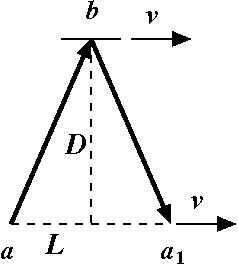
| MadSci Network: Physics |
The famous Michelson–Morley (M&M) experiment has been
questioned many times for numerous errors in the experimental apparatus
and its interpretation. To begin with, the formula that they
give for the length of the light ray moving perpendicular to
the ether (the path aba1 in their figure 2) is wrong.
They give
|
You can see a detailed discussion of this point in The Special
Theory of Relativity by David Bohm, chapter IV. By chance the
correct formula gives the same result as the one used by M&M because
the approximation to fourth order in β gives the same result:
|

|
In the experiment M&M measured the displacement of the interference fringes at 16 different orientations of the light beams. Half of them correspond to the same orientations relative to the Earth motion. Therefore M&M give 9 measurements for a full rotation. Notice that the displacements tend to decrease in the noon observations, and increase in the afternoon observations. That must be a systematic effect or error. It could be due to a thermal effect on the components, some drift of mechanical parts as the float rotates or any other effect that accumulates on the measurements and is evidently much bigger than the effect of ether drift. We don't have to know the cause of this effect because we are only concerned with relative differences of the position of the fringes on top of any systematic effects. Those differences were calculated by fitting a straight line to the displacements in the table. Unfortunately M&M do not explain this in their article, and do not give the fitted lines that they used. They did so in a previous article in an earlier experiment on ether drift in The American Journal of Science, Vol. 22, p. 120 (1881), which by the way also has the wrong formulae for the difference in distances between the rays. I guess this is what happens when scientific articles are not refereed. Fitting a line to the displacements is the simplest supposition that we can make to guess how an unknown systematic effect or error may affect the measurements.
I fitted a line to the “Final mean” of the table in the M&M
article that matches the two points in columns labeled 16 and 8 and got
| x | 0 (16) | 1 | 2 | 3 | 4 | 5 | 8 | 7 | 8 |
| y (Final mean) | 0.784 | 0.762 | 0.755 | 0.738 | 0.721 | 0.720 | 0.715 | 0.692 | 0.661 |
| diff | 0 | 0.006625 | -0.00175 | -0.0001251 | 0.0015 | -0.01288 | -0.02325 | -0.01562 | 0 |
The differences that I got between the fitted line and the measured displacements more or less match those of figure 6 on the M&M article. The expected differences had the sinusoidal form shown on figure 6 of the article with a maximum amplitude of 0.44 in wavelengths. The measured differences have a maximum of -0.023, which is about 20 times lower than the maximum expected difference as M&M say. The afternoon measurements have even lower differences. M&M did not quote error bars for their measurements, but this was enough for some people to dismiss the ether hypothesis.
There have been numerous objections to the M&M experiment. Perhaps the most important one is that the experiment was based on the reflexion and transmission of light beams on mirrors and glasses. It can be shown that when a light wave enters a transparent medium, it is substituted by a wave that travels at the speed of the medium in a very short distance inside the medium. This means that the two light rays were necessarily traveling with the speed of the apparatus and were unaffected by the ether, should it exist. You can find the details on this point in Classical Electrodynamics by J. D. Jackson, Second Edition, (1975), section 11.2. That same book discusses more recent experiments, which are assumed to be “error free” as far as we can tell to prove the constancy of the speed of light in moving reference frames. In any case, the M&M experiment was not the first nor the last time that a major theory is born out of erroneous assumptions. Galileo believed that ocean tides were experimental proof that Earth rotates and moves around the Sun, even though many of his contemporaries believed that tides may be related to the Moon because their periodicity coincided with that of the Moon. You can read more about Galileo and the tides in the article by Rossella Gigli in the pages of The Galileo Project. Einstein really formulated special relativity because he did not like the idea of an absolute frame, where physical laws were valid. He wanted symmetry between all inertial reference frames. There should not be a difference in physical laws if a magnet moves relative to a conductor wire or the wire moves relative to the magnet, said Einstein. Galileo and Einstein were looking for simpler and consistent pictures of the Universe regardless of what experience may tell us.
Greetings,
Vladimir Escalante Ramírez
Center for Radio Astronomy and Astrophysics
Morelia, Michoacán, México
Try the links in the MadSci Library for more information on Physics.